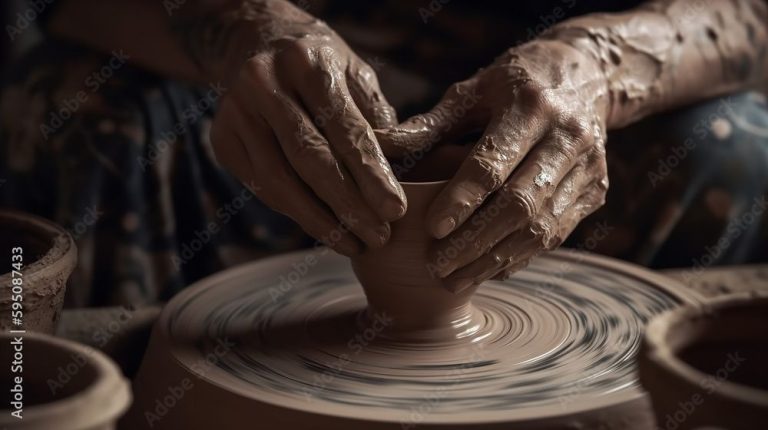Can You Rehydrate Das Clay?
What is Das Clay?
Das clay is an air-dry modeling clay that doesn’t require baking or firing. It is made from a mix of minerals, polymers and water. When exposed to air, Das clay hardens and becomes permanently fixed, allowing you to create lasting sculptures and models.
Unlike oven-bake clays like polymer clay, Das clay does not require heat to set. It hardens naturally at room temperature over the course of 24-48 hours. This makes it easy to use for crafts, school projects, clay modeling and more. The air-dry feature also means that Das clay models don’t need to be kiln-fired at high temperatures.
Das clay comes in a variety of colors including white, black, red, blue and more. It has a smooth, doughy texture that is easy to shape and mold. Das clay is non-toxic, making it safe for kids to handle and play with.
Benefits of Das Clay
Das Clay is an air-drying modeling clay that provides a range of benefits for both kids and adults. Here are some of the key advantages of using Das Clay:
Doesn’t Require Baking or Firing
Unlike many clays, Das Clay doesn’t need to be baked in an oven or kiln in order to harden. It air dries at room temperature into a strong, durable model. This makes it very convenient to use and ideal for projects where you don’t want to worry about having access to a kiln.
Easy for Kids to Use
Das Clay is an excellent choice for children because it doesn’t get messy like some clays. It doesn’t dry out when exposed to air like traditional modeling clay. Das Clay maintains a consistent texture that is easy for little hands to manipulate into creative shapes and sculptures.
Self-Hardening
One of the best features of Das Clay is that it hardens on its own. There’s no baking required to set the models. Simply mold the clay, let your creation air dry for 24-48 hours, and it will harden into a long-lasting craft. This allows for making detailed sculptures without fear of warping or cracking during baking.
Can Das Clay Be Rehydrated?
Yes, Das clay can be rehydrated after drying out. Das clay is an oil-based modeling clay that is designed to stay malleable and workable. When stored properly in an airtight container, Das clay can maintain its flexibility for years. However, if the clay is left uncovered or exposed to air for prolonged periods, it will begin to dry out and become stiff.
The great thing about Das clay is that you can bring it back to its original supple state by adding a little water. By rehydrating dried out Das clay, you can restore its smooth texture and revive the clay for more modeling and crafting projects.
Rehydrating Das clay is a simple process of adding small amounts of water and kneading it in until the clay becomes malleable again. With a little time and effort, that bag of Das clay that has hardened from drying out can be rehydrated and ready to use once more.
How to Rehydrate Das Clay
Rehydrating Das clay is a simple process that involves just a few steps:
Add water: Start by adding a small amount of water directly to the clay. Only add a little at first, such as a teaspoon or two per block of clay. You can always add more, but you don’t want to oversaturate it.
Knead: Once you’ve added some water, start kneading it into the clay. Knead it thoroughly to distribute the moisture evenly throughout the clay. The clay will start to become more pliable as you knead the water in.
Allow to sit: After kneading, cover or wrap the clay and let it sit for 10-15 minutes. This gives the clay time to fully absorb the water.
Knead again: Uncover the clay and knead it once more. Check the consistency and add more water if needed. Continue kneading until the clay is smooth, pliable, and has the desired consistency.
Following this simple process of adding water, kneading, sitting, and repeating will rehydrate dried out Das clay and restore it to a usable state. Start with small amounts of water and take your time to evenly distribute the moisture throughout the clay.
Tips for Rehydrating
When rehydrating your Das clay, follow these tips for best results:
Work in small batches – Only rehydrate the amount of clay you plan to use in a project. Rehydrating large amounts makes it harder to distribute the moisture evenly. Rehydrate in quarter or half blocks at a time.
Use room temperature water – Cold water will shock the clay and make it difficult to absorb moisture. Lukewarm, room temperature water works best.
Knead thoroughly – After adding water, knead the clay vigorously with your hands until the moisture is evenly distributed throughout. This prevents overly wet or dry spots.
Signs Das Clay Needs Rehydrating
One of the clearest indicators that your Das clay could benefit from rehydration is if it feels dried out or crumbly. When clay loses moisture over time, it can become difficult to mold and shape properly. The clay won’t stick together well, and pieces will fall off as you try to attach them.
You may also notice cracks or fissures in the clay if it has become overly dried out. When clay is in optimal condition, it should feel smooth, pliable, and moldable without crumbling or cracking. So if your clay is falling apart as you try to sculpt with it, that’s a telltale sign that it needs more moisture added back in through rehydration.
The clay may also seem harder than normal if it has lost moisture. Properly conditioned clay should have a soft, smooth texture that responds well to pressure. If the clay feels too firm or stiff, rehydrating it will help restore that softness.
Visually inspecting the clay and taking note of any cracks, crumbs, or sections that are falling off as you work with it will help you determine if it’s time to rehydrate. Testing the texture and moldability will also reveal if it has become too dried out for enjoyable sculpting. With the proper amount of water added back in, you can restore dried Das clay to its optimal smooth, flexible state.
How Much Water to Add
When rehydrating Das clay, it’s important to add water gradually instead of all at once. Start with just a small amount of water. A few spritzes from a spray bottle, or 1-2 teaspoons of water is a good starting point.
Mix the clay and let it sit for 5-10 minutes to absorb the moisture. Then, check the consistency. If needed, add a little more water, another spritz or 1-2 teaspoons. Continue adding water in small amounts, mixing thoroughly and letting sit in between, until the clay reaches the desired smooth, flexible consistency.
Adding too much water at once can over-saturate the clay, creating a muddy texture that’s difficult to work with. Going slowly helps ensure you get the right moisture level without overdoing it.
It’s generally best to use the least amount of water needed. Start with small amounts and add conservatively until the clay feels pliable. The clay should be moist but not dripping wet or watery.
Rehydration Troubleshooting
If your clay is still too dry and crumbly after rehydrating, you may need to repeat the process by adding more water. Here are some tips for troubleshooting:
– Make sure you are using enough water – the clay will absorb a lot of water before becoming malleable again. Try immersing it in water for a longer period of time.
– Knead the clay thoroughly after adding water to evenly distribute the moisture throughout.
– If kneading by hand, the warmth from your hands can help soften the clay.
– Add water gradually and knead until the clay reaches the desired consistency. Too much water at once can make the clay slimy.
– Let the clay rest for 10-15 minutes after kneading to allow the water to fully absorb before assessing if it needs more.
– If still too dry and crumbly, add a little more water at a time and repeat kneading and resting until the clay is smooth, pliable, and no longer crumbling.
– Be patient and persistent. It can take some effort to fully rehydrate very dried out clay.
Storing Rehydrated Clay
After rehydrating your Das clay, it’s important to store it properly so it doesn’t dry out again. Here are some tips for keeping your clay moist and ready to use:
Keep the clay in an airtight container. A plastic container with a tight fitting lid works best. Tupperware or other food storage containers are a good option.
Wrap the clay tightly in plastic wrap. Press the wrap against the surface of the clay to minimize air exposure.
Seal the clay in a ziploc bag, squeezing out excess air before sealing. This prevents moisture from evaporating.
Regardless of storage method, check on the clay every few days. If condensation forms on the inside of the container or bag, that means the clay is still moist. If not, it may need a bit more water.
With proper storage, rehydrated Das clay can be kept moist and workable for weeks or months. Just be sure to keep it as airtight as possible. Adding a small damp paper towel to the storage container can also help maintain moisture levels.
Alternatives to Rehydrating
If your Das clay is too dry and crumbly to work with, you have a few options besides trying to rehydrate it:
Buy New Clay
The simplest solution is to purchase a new pack of fresh Das clay. This will ensure you have perfectly soft and pliable clay to work with for your projects. Buying new clay avoids the hassle of trying to recondition hard, dried out clay.
Use a Clay Softener
Special clay softening products are available that can help make hardened clay workable again. These are typically liquid solutions that you mix into the dry clay to soften it. Clay softeners containing glycerin or dimethyl sulfoxide (DMSO) work well for restoring dried Das clay.
Blend with Fresh Clay
You can mix some dried out Das clay with some fresh new clay to improve its consistency. The moisture from the new clay will help condition the older hardened clay when blended together. Start with a 1:1 ratio and adjust as needed to reach the desired consistency.


